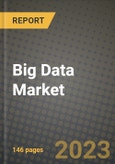The big data software market has become a cornerstone of digital transformation, providing businesses with the tools to process, analyze, and visualize vast amounts of information. This market encompasses a wide array of solutions, including data integration platforms, analytics tools, visualization software, and data management systems. By leveraging big data software, organizations can identify patterns, predict trends, and make data-driven decisions that improve efficiency, enhance customer experiences, and create new revenue opportunities.
In recent years, the market has been shaped by the growing adoption of cloud-based and hybrid deployment models. These flexible environments allow businesses to scale their data operations on demand, optimize costs, and maintain performance as data volumes grow. Moreover, the integration of advanced technologies - such as artificial intelligence (AI), machine learning (ML), and real-time analytics - has expanded the capabilities of big data software, enabling companies to unlock deeper insights, automate processes, and respond more quickly to changing market conditions.
Regionally, North America continues to lead the big data software market due to its strong technological infrastructure, mature enterprise landscape, and early adoption of cutting-edge analytics solutions. Europe and Asia-Pacific are also key markets, driven by the rapid digitization of industries, increasing regulatory compliance requirements, and a growing awareness of the strategic importance of data. As businesses worldwide continue to generate ever-increasing volumes of data, the big data software market is poised for robust growth, powered by ongoing innovation and a rising demand for actionable intelligence.
Key Insights - Big Data Software Market
- Growing adoption of AI and ML technologies to enhance predictive and prescriptive analytics capabilities.
- Increased use of real-time data processing and streaming analytics for faster decision-making.
- Rising emphasis on data visualization and user-friendly interfaces to democratize data access within organizations.
- Exponential growth in data volumes generated by IoT devices, social media, and enterprise systems.
- Need for organizations to remain competitive through data-driven strategies and operational efficiencies.
- Advancements in cloud computing and open-source big data platforms, lowering barriers to entry for businesses of all sizes.
- High costs and complexity of implementing and maintaining sophisticated big data software solutions.
- Ensuring data security and compliance with evolving regulations and standards.
- Shortage of skilled data professionals capable of effectively using advanced big data software tools.
Future of the Big Data Market - Opportunities and Challenges
Growth momentum is expected to remain strong, propelled by decarbonization initiatives, electrification of transport, modernization of industrial processes, and increasing adoption of digital and automated solutions. The acceleration of renewable integration, grid modernization, and distributed storage is unlocking new applications for Big Data technologies. Expanding investments in energy transition, clean mobility, and industrial modernization programs across emerging economies are also key drivers.However, challenges persist. Heightened raw material price volatility, tightening global regulations, supply-demand imbalances, and intense competition pose risks to profitability. Geopolitical uncertainties, trade restrictions, and currency fluctuations further complicate planning. To remain competitive, players must align with sustainability standards, adapt to localized compliance regimes, and manage rising operational costs effectively.
Big Data Market Analytics
The report employs rigorous tools, including Porter’s Five Forces, value chain mapping, and scenario-based modeling, to assess supply-demand dynamics. Cross-sector influences from parent, derived, and substitute markets are evaluated to identify risks and opportunities. Trade and pricing analytics provide an up-to-date view of international flows, including leading exporters, importers, and regional price trends.Macroeconomic indicators, policy frameworks such as carbon pricing and energy security strategies, and evolving consumer behavior are considered in forecasting scenarios. Recent deal flows, partnerships, and technology innovations are incorporated to assess their impact on future market performance.
Big Data Market Competitive Intelligence
The competitive landscape is mapped through the proprietary frameworks, profiling leading companies with details on business models, product portfolios, financial performance, and strategic initiatives. Key developments such as mergers & acquisitions, technology collaborations, investment inflows, and regional expansions are analyzed for their competitive impact. The report also identifies emerging players and innovative startups contributing to market disruption.Geographic Coverage
- North America: United States, Canada, Mexico
- Europe: Germany, France, UK, Italy, Spain, Rest of Europe
- Asia-Pacific: China, India, Japan, South Korea, Australia, Rest of APAC
- Middle East & Africa: GCC, North Africa, Sub-Saharan Africa
- South & Central America: Brazil, Argentina, Rest of the region
Research Methodology
This study combines primary inputs from industry experts across the Big Data value chain with secondary data from associations, government publications, trade databases, and company disclosures. Proprietary modeling techniques, including data triangulation, statistical correlation, and scenario planning, are applied to deliver reliable market sizing and forecasting.Customization Options
The report can be tailored with additional modules such as:- Detailed trade & pricing analytics
- Technology adoption roadmaps and patent analysis
- PESTLE & macroeconomic impact analysis
- Country-specific forecasts and regulatory mapping
- Capital requirements, ROI models, and project feasibility studies
Key Questions Addressed
- What is the current and forecast market size of the Big Data industry at global, regional, and country levels?
- Which types, applications, and technologies present the highest growth potential?
- How are supply chains adapting to geopolitical and economic shocks?
- What role do policy frameworks, trade flows, and sustainability targets play in shaping demand?
- Who are the leading players, and how are their strategies evolving in the face of global uncertainty?
Big Data Market Segmentation
By Component (Software, Services), By Deployment Mode (Cloud Based, On-Premise), By Industry (Banking, Discrete Manufacturing, Professional Services, Process Manufacturing, Government, Other Industries)This product will be delivered within 1-3 business days.
Table of Contents
Companies Mentioned
- Alphabet Inc.
- Microsoft Corporation
- Hitachi Vantara Corporation
- Amazon Web Services Inc.
- Siemens AG
- Hewlett-Packard Company
- International Business Machines Corporation
- Cisco Systems Inc.
- Oracle Corporation
- Broadcom Inc.
- ServiceNow Inc.
- Dassault Systemes SE
- OpenText Corporation
- SAP SE
- Micro Focus International Limited
- Splunk Inc.
- Zoho Corporation
- Snowflake Inc.
- Cloudera Inc.
- Confluent Inc.
- Sumo Logic
- Qubole Inc.
- TIBCO Software Inc.
- SAS Institute Inc.







